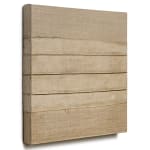Sébastien de Ganay
Untitled, 1992
Linen, folding and collage
70 x 70 x 7 cm
27 1/2 x 27 1/2 x 2 3/4 inches
27 1/2 x 27 1/2 x 2 3/4 inches
Copyright The Artist
Photo: Simon Veres
In der frühen Arbeit Untitled (1992), aus der Serie der Folded Linen, lässt Sébastien de Ganay die klassische Malerei hinter sich und setzt erstmals durch Faltungen des Leinwandstoffs den Bildträger...
In der frühen Arbeit Untitled (1992), aus der Serie der Folded Linen, lässt Sébastien de Ganay die klassische Malerei hinter sich und setzt erstmals durch Faltungen des Leinwandstoffs den Bildträger in den Fokus. Das Material der Leinwand wird durch die Falten zur reliefartigen Oberfläche, die durch ein Spiel von Licht und Schatten an Volumen gewinnt und so die Grenze zwischen Bild und Objekt auflöst. Mit seinem Interesse, die Zweidimensionalität der Malerei hinter sich zu lassen, reiht sich de Ganay in eine Tradition experimenteller Kunstschaffender ein. In diesem Sinne sind beispielsweise die in den 1960er Jahren entstandenen Achromes des italienischen Arte-Povera Künstlers Piero Manzoni weisend für de Ganays Auseinandersetzung mit gefaltetem Leinenstoff. In den Wandarbeiten beider Künstler steht die Materialität im Zentrum und der Duktus des Malers verschwindet. An dessen Stelle tritt eine Auseinandersetzung mit der Beschaffenheit des Materials an sich und der Struktur seiner Oberfläche, an der eine Handschrift des Künstlers nicht mehr lesbar ist. Das Kunstwerk erfährt eine Anonymisierung, die sich vom Bild hin zum Objekt verlagert. Dieser Umgang mit der Leinwand ist Ausgangspunkt für eine tiefgehende Auseinandersetzung de Ganays mit Faltungen, welche sich über die folgenden Jahrzehnte bis heute weiterzieht. So schafft de Ganay mit Untitled (1992) ein Malerei-Objekt, dass die Grundlage zukünftiger Werkserien bildet, die den Raum zwischen Bild und Skulptur öffnen und über Gattungsgrenzen hinaustreten.
With his early work Untitled (1992) of the series Folded Linen, Sébastien de Ganay leaves classical painting behind and for the first time focuses on the image carrier by folding the canvas fabric. Through the folds, the canvas material becomes a relief-like surface that gains volume through a play of light and shadow, thus dissolving the boundary between picture and object. With his interest in leaving the two-dimensionality of painting behind, de Ganay joins a tradition of experimental artists. In this sense, for example, the Achromes by the Italian Arte-Povera artist Piero Manzoni, created in the 1960s, point the way for de Ganay's examination of folded linen fabric. In the wall works of both artists, the materiality is at the center and the characteristic style of the painter disappears. The examination of the nature of the material itself and the structure of its surface, in which the artist's handwriting is no longer legible, takes its place. The work of art experiences an anonymization that shifts from the picture to the object. This way of working with the canvas is the starting point for de Ganay's profound examination of folds, which continues over the following decades until today. With Untitled (1992), de Ganay creates a painted object that forms the basis of future series of works that open up the space between painting and sculpture and transcend genre boundaries.
With his early work Untitled (1992) of the series Folded Linen, Sébastien de Ganay leaves classical painting behind and for the first time focuses on the image carrier by folding the canvas fabric. Through the folds, the canvas material becomes a relief-like surface that gains volume through a play of light and shadow, thus dissolving the boundary between picture and object. With his interest in leaving the two-dimensionality of painting behind, de Ganay joins a tradition of experimental artists. In this sense, for example, the Achromes by the Italian Arte-Povera artist Piero Manzoni, created in the 1960s, point the way for de Ganay's examination of folded linen fabric. In the wall works of both artists, the materiality is at the center and the characteristic style of the painter disappears. The examination of the nature of the material itself and the structure of its surface, in which the artist's handwriting is no longer legible, takes its place. The work of art experiences an anonymization that shifts from the picture to the object. This way of working with the canvas is the starting point for de Ganay's profound examination of folds, which continues over the following decades until today. With Untitled (1992), de Ganay creates a painted object that forms the basis of future series of works that open up the space between painting and sculpture and transcend genre boundaries.



